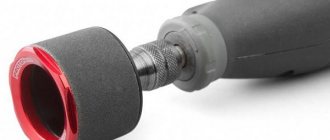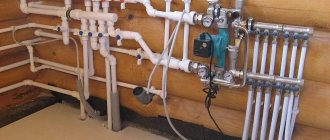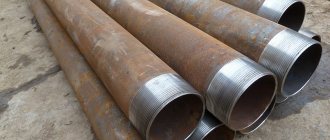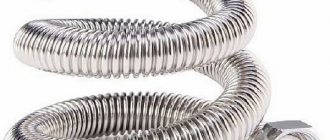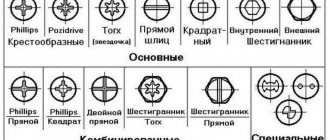Roofing screws of various sizes for fastening roofing materials to wooden sheathing, as well as metal structures, consist of:
- hex head reinforced with a press washer;
- an elastomer sealing gasket assembled together with a spherical washer;
- threaded bases;
- drill tip.
Depending on the technical characteristics, roofing screws for fastening sheet roofing material are divided into two large groups:
- for fastening to metal structures;
- for fastening to wooden structures (wooden sheathing);
The difference between self-tapping screws “for wood” and “for metal” can be determined by their appearance, namely by the pitch of the thread, the diameter of the base and the tip in the form of a drill (see tables).
Types of roofing screws
There are several technical characteristics of roofing screws by which they are usually classified.
- According to the shape of the head: there are hexagonal self-tapping screws, the head of which is immersed in the surface; and round with a thread for a screwdriver.
- By function: for fastening the sheathing to the rafters, for fixing the roof to the sheathing, etc.
- According to the material from which the screws are made: self-tapping screws are made of stainless or carbon steel.
- In size: the sizes of self-tapping screws for roofing vary from 16 to 150 millimeters in length, and in diameter these products can be 4.8, 5.5, 6.3 millimeters.
- According to the material for fixing: there are self-tapping screws for fastening to metal or wooden bases.
Functions of self-tapping screws
Self-tapping screws are intended for reliable fastening of structural parts and products to each other. At the same time, their design makes the installation process simple and convenient.
The tip of a self-tapping screw, made in the form of a drill, allows you to penetrate the material without much effort and without damaging the products, without performing preliminary drilling. The presence of a continuous thread guarantees high-quality and reliable fixation. The head for the roofing screw is made in such a way as to ensure maximum ease of tightening with a screwdriver or wrench.
Another advantage is the presence of a washer with an elastic gasket, due to which, even when tightened tightly, there is no squeezing or damage to the products. The elastic gasket also makes the connection waterproof, and the structure is not only durable, but also reliably protected from corrosion.
The variety of types and sizes of roofing screws make them suitable for installing various types of roofing products. In particular, self-tapping screws for wood and metal differ significantly from each other both in the shape of the tip and in diameter, as well as in the features of the thread.
Different types of self-tapping screws are used to secure different roofing materials. For example, galvanized self-tapping screws are used to fasten rafters, and self-tapping screws with a press washer are used to install sheathing. Therefore, you must first decide on the type of product, and then calculate the required quantity for the work.
The required length of roofing screws for certain installation work is determined based on the thickness of the products being fastened and the required penetration depth of the screws.
Weight
The construction of large industrial facilities, compared to small domestic buildings, requires the purchase of roofing screws of different weights. They can be purchased as a small package, which is enough for the roof of a small room.
But it is worth considering that this option is not low in cost compared to selling hardware by weight.
- Buying self-tapping screws by weight will not cost the buyer too much, but on the contrary, you can even save money.
- To do this, you need to know how many screws are needed for the job and their weight.
- You can also calculate the weight of one self-tapping screw, knowing how many of them are in one kilogram.
As for purchasing hardware in bulk in packaging, there are some nuances here. The packaging of such products can be more than 1000 thousand in one container.
Moreover, if you know how many self-tapping screws are needed to fasten the roof, then this purchase will be justified. Otherwise, the products will no longer be needed and the money will be wasted.
Choice
Once all the necessary characteristics have been determined - diameter, length, color of screws, etc., all that remains is to choose high-quality products for reliable installation.
The quality of self-tapping screws can be determined using the following criteria:
- Well-known manufacturers put a stamp on the cap of the product; Accordingly, in its absence, you can be wary of counterfeits made from low-quality steel.
- The thickness of the galvanized layer is indicated on the packaging (normally more than 12 microns).
- The washer must have a tightly attached gasket at least 2 millimeters thick. When compressing the washer with pliers, the gasket should not deteriorate or peel off.
- If there is a color color on the surface of the self-tapping screw, it should also not be damaged by control bending with pliers.
To guarantee the purchase of high-quality self-tapping screws, we can recommend branded European products. Of course, such products will cost more in price, but the high quality of the manufacturing material, the reliability and durability of the product, along with a long-term warranty from the manufacturer, will serve as sufficient compensation for the costs incurred.
Standard sizes, length
In accordance with GOST standards, the diameter of roofing screws for wood is 4.8 millimeters. Their length can be different and be 29, 35, 38, 50, 60, 65, 70, 80 millimeters. Self-tapping screws longer than 60 millimeters are used in cases where it is necessary to attach wavy material (for example, slate) to the tree in the area of the wave crest.
The diameters of roofing screws for metal may vary slightly: 4.8, 5.5, 6.3 millimeters. Products with diameters of 4.8 and 5.5 millimeters correspond to a length of 16-80 millimeters; self-tapping screws with a diameter of 6.3 millimeters - length 19-150 millimeters. Self-tapping screws of short length (up to 29 millimeters) are used for fastening metal products to each other, long lengths (more than 80 millimeters) are used for fixing with multilayer sheathing.
Rules for fastening roof elements
The technological features of the fastening process depend on a number of factors: the type of products used, their thickness, characteristics of the sheathing, etc. However, in all cases, the length of the roofing screw must exceed the total thickness of the products being fastened by at least 3 millimeters.
In most cases, self-tapping screws can be attached to a particular material without pre-drilling. However, in some situations, through drilling may be necessary first, and then the self-tapping screw is screwed in. Most often, this is resorted to when working with thick metal products to avoid damage to the screw tip.
Pre-drilling is carried out using a drill, and the diameter of the drill should be 0.5-1 millimeter smaller than the diameter of the self-tapping screw. When working with thick metal products, some experts recommend making holes in them that are larger than the diameter of the screws. This is done in order to provide the roofing elements with some mobility, which is important in the presence of serious temperature fluctuations.
Various tools can be used for tightening, depending on the type of screw head, for example a wrench, screwdriver, screwdriver, etc.
You should be careful about the force with which the twisting process is performed. It should be sufficient to tightly press the washer with the gasket, but you should not overdo it here - this can lead to damage to the roofing materials.
It is worth briefly mentioning in which specific areas the fastening of certain roofing products is carried out. Corrugated sheeting or metal tiles are attached where there is the greatest contact with the sheathing, that is, at the base of the waves. Slate, on the contrary, is attached to the crest of the wave (for more details: “What types of slate nails are there - sizes, rules for using nails and screws for slate”). If the roof is assembled from small elements and parts, then the fastening is carried out in overlaps hidden from view.
Calculation of the required number of screws
The number of screws per square meter required for fastening a particular material is usually indicated in the instructions for the roofing products themselves. Often, along with this, a diagram of their location is also described. The instructions for use usually indicate other nuances, for example, the need to use different types of screws, etc.
Most often, per square meter of metal tile products requires 2-3 short screws for metal and 3-4 medium screws for wood. As for the additional elements, about ten long self-tapping screws are required per meter of their length.
If a slate covering is being installed, then each sheet of the product requires an average of 2 to 4 wood screws.
Of course, the above figures are approximate and averaged, and for more specific calculations you need to have a detailed roof arrangement diagram on hand.
Features of using self-tapping screws for wooden roof structures
For the purpose of fastening roofing elements to a wooden base, several types of fasteners are usually used:
- To install the sheathing, use roofing screws with a press washer.
- For rafters - simple galvanized nails and screws.
- Directly for the roof itself - wood screws.
Features of roofing wood screws are their small diameter and sparse carving. They are optimally suited for attaching all kinds of roofing elements to a wooden base.
Preparing the sheathing for covering
Before laying it is necessary to make a high-quality sheathing . It is made from wooden planks treated with an antiseptic composition. It prevents rotting due to condensation dripping from the inside of the roof. During installation, it is necessary to correctly determine the distance between the planks ( sheathing pitch ) and the distance between the screws.
Based on SNiP data, the following rules for its calculation are recommended:
- with a profile height of 35 mm (HC35) and an inclination angle of up to 15º - up to 0.5 m, more than 15º - 1 m;
- with a profile height of 60 mm (H60) and an inclination angle of 8º – no more than 3 m;
- with a profile height of 70 mm (H75) and an inclination angle of 8º – no more than 4 m;
NOTE!
There must be a ventilation gap between the sheathing and the waterproofing . To create it, a counter-lattice is installed from rafter strips or metal purlins attached along the rafters.
Self-tapping screws for metal structures
To fasten roofing materials to a metal base, metal roofing screws are used, as well as self-tapping screws with a press washer and a drill.
Self-tapping screws for metal, in comparison with the corresponding wood products, are somewhat shorter in length in the case of the same diameters. The threads on them are located more often. The tip is made in the form of a special metal drill, which allows you to easily screw them into metal products. In particular, they can easily drill 1 mm metal base and 5 mm metal roofing products.
Cheat sheet for a novice master
The type of thread determines the purpose of the hardware. Self-tapping screws differ in the number and frequency of turns. There are several thread pitch options:
- medium – typical for universal general-purpose hardware. Self-tapping screws with a medium thread pitch are quite common and are suitable for working with different materials;
- frequent - suitable for installing metal profiles with a thickness of up to 0.9 mm. In this case, you must first make a hole for the fasteners. This is a type of relatively expensive hardware that has a drill at the end;
- rare - for attaching products to soft surfaces. For example, plastic, gypsum, asbestos;
- medium - for driving into brick or concrete bases;
- asymmetrical - for mounting products in wooden structures, plywood, chipboard;
- combined with notches - mounted without dowels.
Features of roofing screws with a press washer
Roofing self-tapping screws with a press washer are designed for screwing roofing materials to the base as tightly as possible. Their hat is shaped like a hemisphere with a cross-shaped cut in the middle for twisting. The diameter of these fasteners is always the same - 4.2 millimeters, while the length ranges from 13-76 millimeters.
It should be noted that this type of screws is not recommended for use in direct contact with water.
Self-tapping screws with a press washer come in two types:
- galvanized sharp - designed for fixing roofing elements to a wooden base, the threads on them are deep and sparse;
- with a drill - their drill-shaped tip is designed for drilling and screwing into a metal base or other products; the thread is superficial and dense.
Types of hats
The type of cap determines the intended purpose of the hardware. Let's look at the features of caps in self-tapping screws:
- secret - when screwed in, the cap is not visible, since it is completely immersed in the surface of the object;
- hemispherical profile – the clamping cap has an increased area, which ensures reliable fastening;
- hemispherical profile with a small washer - characterized by a small head height, most suitable for sheet materials. For example, roofing materials;
- secret small cap - notable for its smooth transition from cap to trunk. When screwing in, you can apply more force without fear of deformation of the fastener;
- hexagonal - it is easy to install because it requires less effort;
- funnel-shaped - a special key is required for installation. The connection is invisible.
Difficulties may arise when screwing in a self-tapping screw. This is especially true for seals in foundations. But, if difficulties arise with screwing in, it is important to evaluate the feasibility of installing a self-tapping screw. Because when unscrewing it will take much more effort. When choosing fasteners, objectively assess the load on it. For example, if you need to connect wooden parts, you should not spend money on expensive hardware.
You can screw in the screws manually or using an electric screwdriver. For roofing work, you will need a screwdriver; for simpler tasks, a screwdriver will be enough.
Choosing between self-tapping screws and slate nails
Before the advent of self-tapping screws, fastening roof elements to each other was carried out using simpler and cheaper products, the main ones of which were slate nails. A distinctive feature of such nails is that they are galvanized and equipped with a wide washer. In addition to this, when driving them, a rubber gasket is often also used to provide waterproofing.
Connecting roofing products using slate nails is less durable than using self-tapping screws, and the steel material from which they are made is of lower quality. Such nails cannot be used for fastening metal products, and when working with other materials they require preliminary drilling. When driving nails, there is a fairly high risk of damage to products.
Working with self-tapping screws is much simpler and more convenient. It is also important that the self-tapping screws produced have a large number of colors and designs. This allows you to choose the best option for a roofing covering of any color, making it invisible against the general background.
In cases where the priority is the economy of the structure, and you need to equip a cheap roof with a service life of 10-15 years, you can choose slate nails. If the reliability of the structure being built, with a long service life of several decades, comes first, then the use of modern high-quality materials and fastening products, which include roofing screws, is mandatory.
Material consumption
Experts recommend buying a complete set of self-tapping screws, rather than buying different versions of them separately. In this case, it is worth calculating the consumption of roofing fasteners in advance in full accordance with the roof design.
Fasteners should be purchased at an average rate of 8-10 pieces per 1 m2 of roof area. It should be understood that the number of screws per square can be increased if the roof has a non-standard geometric shape or some additional elements.
In the lower part, it is recommended to place fasteners through one wave in each of the sheets of metal tiles, while the self-tapping screw is screwed in in places where the cavity of the wave abuts the profile. It is considered a gross mistake to fasten through the crest of a wave - this can deform the metal tile. Then the screws are screwed through the wave, keeping the rows in a checkerboard pattern.
Sheets of metal tiles are laid overlapped on the sides ; these seams should be secured along the crest of each wave. The end strip is fixed, observing the screw pitch of 500-600 mm. The ridge strips are fixed with special ridge screws; they are also screwed into the roofing through one wave.




